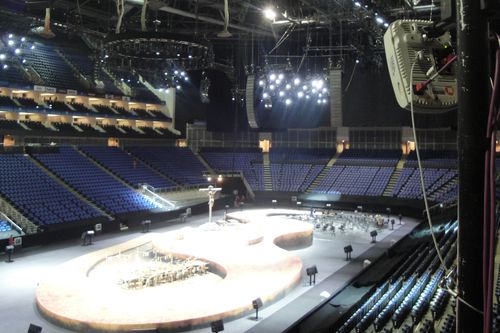When 17,000 people attended each showing of Bizet’s opera Carmen this spring at London’s 02 arena, the sound experience was unlike other operas. Speakers had been installed above and around the periphery of the stage, and as each performer traveled around that stage, his or her voice reached each seat as if emanating directly from the singer’s exact location on stage. This is no simple accomplishment. To ensure the timing and therefore the direction of sound for each performer—to each section of the audience—is still an early science. But in the case of this production of Carmen, as well as a dozen or more theater productions throughout Europe, a company has solved the problem with an RFID-based solution.
British sound engineering firm Out Board has developed a sound-locating system known as TiMax Tracker, using ultra-wideband technology from Ubisense to calculate the location of various tag-wearing performers on the stage. That data is forwarded to the TiMax2 SoundHub audio-controlling software, which determines when a specific performer’s voice should reach each of the speakers deployed throughout the theater or arena and consequently determine when that performers amplified voice should be broadcast on each speaker.
The system predicts the arrival time of sound and thereby, says, Dave Haydon, Out Board’s director, matches the sound location with the visual location of the performers on the stage using a psychoacoustic phenomenon known as precedence. “The importance is authenticity, realism,” he says.
RFID helps accomplish this—a feat that is especially impressive given the size of The O2, which can accommodate as many as 20,000 audience members, in a space that measures 320 meters (1,050 feet) in diameter. Since the TiMax Tracker system was first developed three years ago, it has been used in the 5,000-seat Royal Albert Hall in London as well as 25 to 30 other theaters in the United Kingdom, Sweden, Finland, Norway and Denmark, and is planned for use at an unnamed Broadway musical in New York.
For opera, the quality of sound has been especially challenging once microphones began being used. In a large theater, the sound of the performer’s voice can arrive at audience seats a fraction of a second later than the sound from speakers, reducing the clarity of sound. In addition, as more operas are performed in English to make them more accessible to the English-speaking audience, it is even more critical that a singer’s voice sounds clear, so that words can be understood. By determining exactly where each performer is on the stage, the system can determine how long the sound delay is, to ensure not only the proper amplification of each voice but also the right localization.

Out Board already offered a system to adjust sound according to the location of seats, but did not have an automated way to determine where the performer was on the stage and therefore had to manually adjust sound for that location (for example, the left rear section of the stage). “For years, people said we needed an RTLS system,” says Haydon. Eventually the company discovered the system provided by Ubisense, also located in Cambridge.
Each performer wears a small battery-powered Ubisense RFID tag, which measures 1 inch in length and width and one-third inch in thickness. The tag is attached to the same belt that holds the microphone’s radio transmitter, and it transmits a unique ID number that is linked to the performer’s name in the TiMax system. The tag goes to sleep when off the stage, but when the performer enters the stage, it receives transmissions from RFID readers (called TiMax sensors), waking up the tag and causing it to transmit a 6-8 GHz signal encoded with its own unique ID number. The tag can be read from a distance of up to 100 meters from a TiMax sensor.
The readers send the tag’s ID number to a PC with an Ethernet connection. The Ubisense Location Platform software running on PC calculates the location of the tag based on the angle of signal arrival to each reader and the time at which the signal was received, assigning the location of each tag to a specific zone on stage. At The 02, six TiMax sensors were mounted on pipes or rails above the corporate boxes. The stage itself was divided into 36 sections—a grid of nine zones long and four wide.
Mobility was an important element of the system, with TiMax sensors that could be installed in a matter of minutes. At The 02, Out Board staff was able to calibrate and test the system in less than 45 minutes, Haydon says, once the RFID readers and Ethernet cable had been installed. Around the edge of the circular stage, 30 low-profile speaker arrays were mounted in adjacent pairs on 3-foot-high stands, providing amplified sound to all the lower-tier audience seats, located nearest to the stage. The upper-tier seats, farther from the stage, were covered by 12 overhead speakers.
“The simple objective is to always ensure every audience member receives an acoustic wavefront from each performer about 10 to 20 milliseconds before they receive the reinforcing energy from the speakers. Within this short time difference, the brain integrates the two arrivals together but focuses the listener instinctively into localizing to the precedent arrival coming directly from the performer,” Haydon says. The TiMax Tracker system can follow about 15 to 20 actors at any time, and the software can feed up to 64 separate loudspeaker arrays.
“This all takes place automatically and in real-time, enabling the sound to follow the actors as they cross the stage, without any intervention from the operator,” says Haydon.

